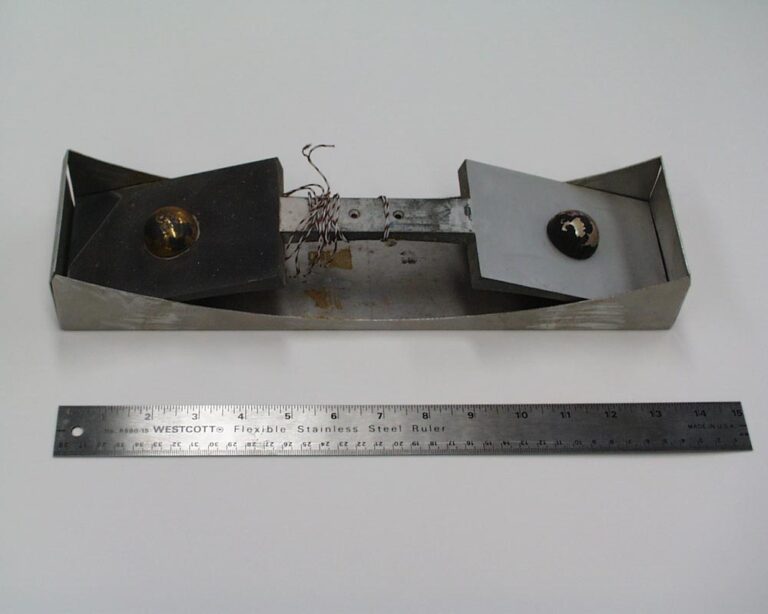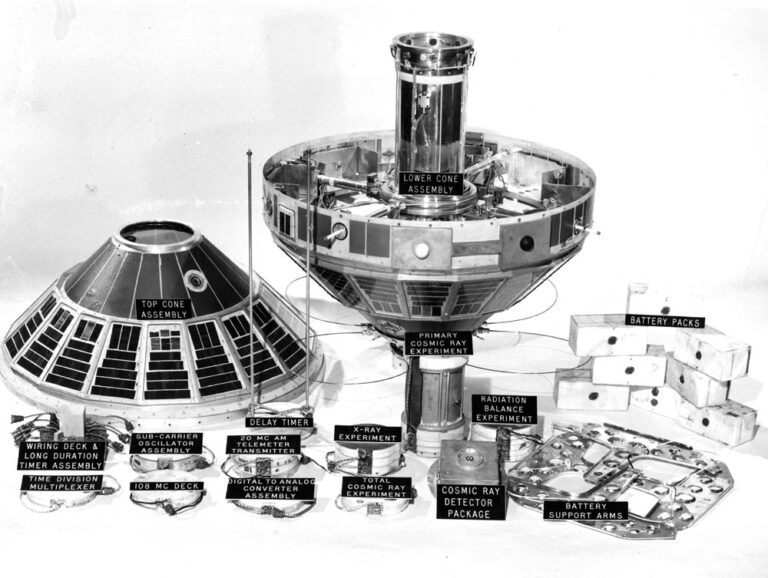Thermal Radiation Experiment (TRE)
The Thermal Radiation Experiment on board the Explorer 7 satellite was launched on 13 October 1959. The instrument (bolometer) was designed and fabricated at the SSEC. A modified version of the bolometer flew on TIROS 3, 4 and 7 and was called the Low-resolution Omndirectional Radiometer.
The Explorer 7 thermal radiation experiment was designed to measure incident and reflected solar UV radiation and terrestrial IR radiation in order to obtain a better understanding of the driving forces of the earth-atmosphere system. The primary instrumentation consisted of five bolometers in the form of hollow silver hemispheres that were thermally insulated from, but in close proximity to specially aluminized mirrors. The hemispheres thereby behaved very much like isolated spheres in space. Two of the hemispheres had black coatings and responded about equally to solar and terrestrial radiation. A third hemisphere, coated white, was more sensitive to terrestrial radiation than to solar radiation. A fourth, which had a gold metal surface, was more sensitive to solar radiation than to terrestrial radiation. The fifth hemisphere, protected from direct sunlight, was used to measure the reflected sunlight. A glass-coated bead thermistor was mounted on the top of each hemisphere to measure the temperature. A complete set of four temperature observations and one reference sample required 30 s. Thus, in each orbit, about 180 temperature measurements could be obtained. The experiment was a success, and usable data were obtained from launch until February 28, 1961.
From National Space Science Data Center, NSSDC ID: 1959-009A-01
Investigators
- Dr. Verner E. Suomi Space Science and Engineering Center (SSEC)
Related Websites
Publications
-
Explorer 7 (1959 IOTA 1) thermal radiation experiment. Data users’ note NSSDC 67-17. Greenbelt, MD, NASA, Goddard Space Flight Center, National Space Science Data Center (NSSDC), March 1967:
-
House, F. B. On the interpretation of long-wave radiation data from Explorer VII satellite. Meteorological satellite instrumentation and data processing, Final scientific report (NASw-65 1958-1968). University of Wisconsin-Madison, Department of Meteorology, Madison, WI, 1968, pp.151-164. Call Number: UW MET Publication No.68.12.M1
-
House, Frederick B. On the interpretation of long wave radiation data from Explorer VII satellite. Meteorological satellite instrumentation and data processing: Final scientific report on NASw-65 1958-1968. University of Wisconsin, University of Wisconsin-Madison, Department of Meteorology, Madison, WI, December 1968, pp.151-164. Reprint # 507
-
Parent, R. J.; Miller, H. H.; Suomi, V. E. and Swift, W. B. Instrumentation for a thermal radiation budget satellite. National Electronics Conference, Chicago, IL, 12-14 October 1959 (also University of Wisconsin Engineering Experiment Station Reprint No.400.). National Electronics Conference, Inc., Chicago, IL, 1960 14p., Reprint # 420.
-
Takasugi, Shoji. Methods of albedo determination from Explorer VII satellite radiation data. University of Wisconsin-Madison, Department of Meteorology, Madison, WI, 1962. UW MET Publication No.62.00.T1.
-
Tucker, Gordon L.. A technique for in-flight calibration of the white sensor on satellite Explorer VII. University of Wisconsin-Madison, Department of Meteorology, Madison, WI, 1962. Call Number: UW MET Publication No.62.00.T2.
-
Shen, William Chuan Chieh. The generation of available potential energy due to horizontal variations in terrestrial radiation as measured by the satellite Explorer VII. University of Wisconsin-Madison, Department of Meteorology, Madison, WI, 1963. UW MET Publication No.63.08.S1.
-
Suomi, V. E. and Parent, R. J. Satellite instrumentation for measurement of the thermal radiation budget of the Earth. 1958 National Telemetering Conference, Baltimore, MD, 2-4 June 1958. Institute of the Aeronautical Sciences, New York, NY, 1958, pp.186-190. Reprint # 5589.
-
Suomi, Verner. The radiation balance of the Earth from a satellite, section 3.3.11 (NSF USNC IGY Project 30.11). Annals of the International Geophysical Year, v. 6, no. 1, 1958, pp.331-340. Reprint # 308.
-
Suomi, V. E.. The thermal radiation balance experiment on board Explorer VII. Juno II summary project report, v.1: Explorer VII satellite. National Aeronatics and Space Administartion (NASA), George C. Marshall Space Flight Center, Washington, DC, 1961, pp.273-305. Reprint # 426.
-
Suomi, Verner E.. Earth’s thermal radiation balance: Preliminary results from Explorer VII. Based on report in NASA Technical Note D-608. EOS, v. 42, no. 4, 1961, pp.467-474. Reprint # 4630.


